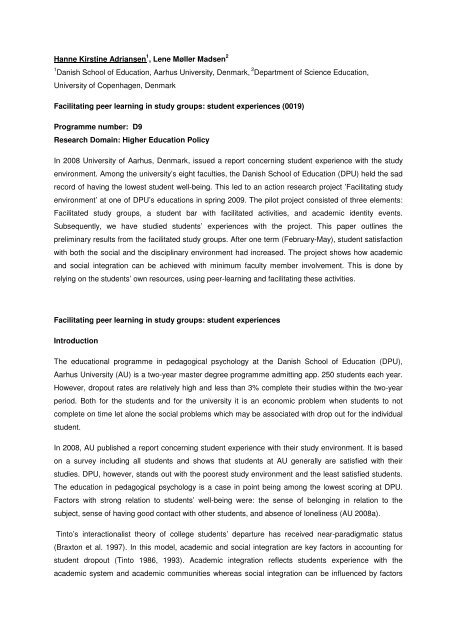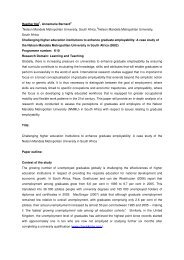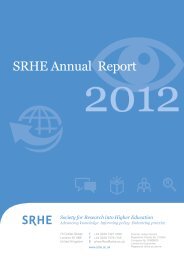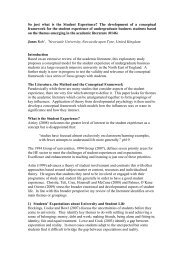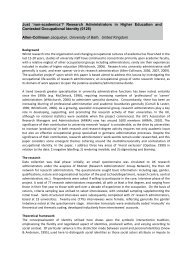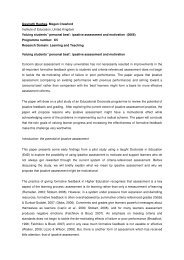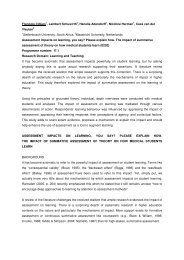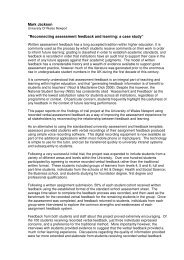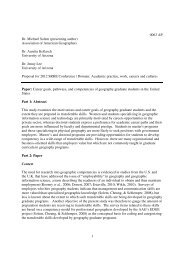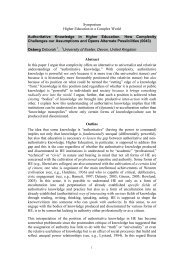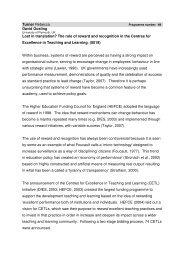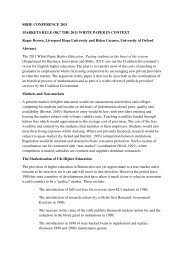Facilitating peer learning in study groups: student experiences (0019)
Facilitating peer learning in study groups: student experiences (0019)
Facilitating peer learning in study groups: student experiences (0019)
Create successful ePaper yourself
Turn your PDF publications into a flip-book with our unique Google optimized e-Paper software.
Hanne Kirst<strong>in</strong>e Adriansen 1 , Lene Møller Madsen 2<br />
1 Danish School of Education, Aarhus University, Denmark, 2 Department of Science Education,<br />
University of Copenhagen, Denmark<br />
<strong>Facilitat<strong>in</strong>g</strong> <strong>peer</strong> <strong>learn<strong>in</strong>g</strong> <strong>in</strong> <strong>study</strong> <strong>groups</strong>: <strong>student</strong> <strong>experiences</strong> (<strong>0019</strong>)<br />
Programme number: D9<br />
Research Doma<strong>in</strong>: Higher Education Policy<br />
In 2008 University of Aarhus, Denmark, issued a report concern<strong>in</strong>g <strong>student</strong> experience with the <strong>study</strong><br />
environment. Among the university’s eight faculties, the Danish School of Education (DPU) held the sad<br />
record of hav<strong>in</strong>g the lowest <strong>student</strong> well-be<strong>in</strong>g. This led to an action research project ’<strong>Facilitat<strong>in</strong>g</strong> <strong>study</strong><br />
environment’ at one of DPU’s educations <strong>in</strong> spr<strong>in</strong>g 2009. The pilot project consisted of three elements:<br />
Facilitated <strong>study</strong> <strong>groups</strong>, a <strong>student</strong> bar with facilitated activities, and academic identity events.<br />
Subsequently, we have studied <strong>student</strong>s’ <strong>experiences</strong> with the project. This paper outl<strong>in</strong>es the<br />
prelim<strong>in</strong>ary results from the facilitated <strong>study</strong> <strong>groups</strong>. After one term (February-May), <strong>student</strong> satisfaction<br />
with both the social and the discipl<strong>in</strong>ary environment had <strong>in</strong>creased. The project shows how academic<br />
and social <strong>in</strong>tegration can be achieved with m<strong>in</strong>imum faculty member <strong>in</strong>volvement. This is done by<br />
rely<strong>in</strong>g on the <strong>student</strong>s’ own resources, us<strong>in</strong>g <strong>peer</strong>-<strong>learn<strong>in</strong>g</strong> and facilitat<strong>in</strong>g these activities.<br />
<strong>Facilitat<strong>in</strong>g</strong> <strong>peer</strong> <strong>learn<strong>in</strong>g</strong> <strong>in</strong> <strong>study</strong> <strong>groups</strong>: <strong>student</strong> <strong>experiences</strong><br />
Introduction<br />
The educational programme <strong>in</strong> pedagogical psychology at the Danish School of Education (DPU),<br />
Aarhus University (AU) is a two-year master degree programme admitt<strong>in</strong>g app. 250 <strong>student</strong>s each year.<br />
However, dropout rates are relatively high and less than 3% complete their studies with<strong>in</strong> the two-year<br />
period. Both for the <strong>student</strong>s and for the university it is an economic problem when <strong>student</strong>s to not<br />
complete on time let alone the social problems which may be associated with drop out for the <strong>in</strong>dividual<br />
<strong>student</strong>.<br />
In 2008, AU published a report concern<strong>in</strong>g <strong>student</strong> experience with their <strong>study</strong> environment. It is based<br />
on a survey <strong>in</strong>clud<strong>in</strong>g all <strong>student</strong>s and shows that <strong>student</strong>s at AU generally are satisfied with their<br />
studies. DPU, however, stands out with the poorest <strong>study</strong> environment and the least satisfied <strong>student</strong>s.<br />
The education <strong>in</strong> pedagogical psychology is a case <strong>in</strong> po<strong>in</strong>t be<strong>in</strong>g among the lowest scor<strong>in</strong>g at DPU.<br />
Factors with strong relation to <strong>student</strong>s’ well-be<strong>in</strong>g were: the sense of belong<strong>in</strong>g <strong>in</strong> relation to the<br />
subject, sense of hav<strong>in</strong>g good contact with other <strong>student</strong>s, and absence of lonel<strong>in</strong>ess (AU 2008a).<br />
T<strong>in</strong>to’s <strong>in</strong>teractionalist theory of college <strong>student</strong>s’ departure has received near-paradigmatic status<br />
(Braxton et al. 1997). In this model, academic and social <strong>in</strong>tegration are key factors <strong>in</strong> account<strong>in</strong>g for<br />
<strong>student</strong> dropout (T<strong>in</strong>to 1986, 1993). Academic <strong>in</strong>tegration reflects <strong>student</strong>s experience with the<br />
academic system and academic communities whereas social <strong>in</strong>tegration can be <strong>in</strong>fluenced by factors
such as the amount and quality of contacts with<strong>in</strong> faculty members (T<strong>in</strong>to 1993), active <strong>learn<strong>in</strong>g</strong>,<br />
fulfilment of expectations for college, <strong>student</strong> <strong>in</strong>volvement, and self-efficacy (Braxton et al. 2000).<br />
This paper presents results from a pilot project at the education <strong>in</strong> pedagogical psychology at DPU. The<br />
project was <strong>in</strong>itiated <strong>in</strong> January 2009 and the goals were twofold: to <strong>in</strong>crease the <strong>student</strong>s’ social and<br />
academic <strong>in</strong>tegration and thereby <strong>in</strong>crease retention; to achieve this with m<strong>in</strong>imal faculty member<br />
<strong>in</strong>volvement. This last po<strong>in</strong>t is important, as we see it as a new contribution to the research field of<br />
<strong>student</strong>s’ social <strong>in</strong>tegration.<br />
The project ‘facilitat<strong>in</strong>g <strong>study</strong> environment’<br />
The project consisted of three elements: facilitated <strong>study</strong> <strong>groups</strong>, a <strong>student</strong> bar with facilitated activities,<br />
and academic identity events. These three elements were chosen <strong>in</strong> order to address some of the<br />
problems highlighted <strong>in</strong> the analysis of the <strong>study</strong> environment (AU 2008b). As we wanted to see how<br />
much we could change an education dom<strong>in</strong>ated by lectures with m<strong>in</strong>imal faculty member <strong>in</strong>volvement,<br />
the activities were outside the classroom and none of them were mandatory.<br />
In this paper we report on the facilitated <strong>study</strong> <strong>groups</strong>. This part was <strong>in</strong>itiated with a call for potential<br />
facilitators among the <strong>student</strong>s. Through a two-day workshop 17 <strong>student</strong>s learned how to facilitate their<br />
own <strong>study</strong> group and to use <strong>peer</strong> <strong>learn<strong>in</strong>g</strong> (similar to a <strong>peer</strong>-<strong>learn<strong>in</strong>g</strong> community (Tosey and Gregory<br />
1998)). Groups of 10-14 <strong>student</strong>s were formed and l<strong>in</strong>ked with one tra<strong>in</strong>ed group facilitator. They met<br />
one hour before every lecture (<strong>in</strong> total 15 times) and were guided by the facilitator through ‘academic<br />
critical’ and ‘personal constructive’ questions relat<strong>in</strong>g to the text. ‘Academic critical’ questions are the<br />
type of questions we usually use. These were supplemented with ‘personal constructive’ questions <strong>in</strong><br />
order to <strong>in</strong>crease the <strong>student</strong>s’ subjective relevancy of the text. All of the activities built on the <strong>student</strong>s’<br />
own resources and <strong>in</strong>volved a m<strong>in</strong>imum of faculty member <strong>in</strong>volvement.<br />
For the evaluation, we made qualitative <strong>in</strong>terviews and focus <strong>groups</strong> <strong>in</strong>terviews with 15 <strong>study</strong> group<br />
facilitators. Furthermore, a questionnaire with both closed and open-ended questions was handed out<br />
at the last lecture and had a response rate of 72%.<br />
Discussion and conclud<strong>in</strong>g remarks<br />
The project led to a remarkable improvement <strong>in</strong> the <strong>student</strong>s’ well-be<strong>in</strong>g measured on a number of<br />
parameters as seen <strong>in</strong> table 1 compared with the 2007 <strong>study</strong> from AU (AU2008a). Foremost the<br />
<strong>student</strong>s experienced a much greater sense of belong<strong>in</strong>g to the <strong>study</strong> <strong>in</strong> pedagogical psychology.<br />
Percentage agree<strong>in</strong>g to the statement<br />
AU<br />
DPU<br />
PP<br />
PP<br />
2007<br />
2007<br />
2007<br />
2009<br />
I feel I belong to a larger community at the <strong>study</strong> 55 24 21 60
The <strong>study</strong> has contributed to my sense of academic belong<strong>in</strong>g at the<br />
<strong>study</strong><br />
74 54 48 69<br />
Generally, my well-be<strong>in</strong>g at the <strong>study</strong> is high 83 69 67 85<br />
The likelihood of social <strong>in</strong>teraction with my fellow <strong>student</strong>s is good 72 32 29 74<br />
In general, the other <strong>student</strong>s are forthcom<strong>in</strong>g 82 78 80 91<br />
I fell lonely – at a daily basis at university 9 16 19 6<br />
I fell lonely – at a daily basis outside university 6 5 5 6<br />
My <strong>in</strong>terest <strong>in</strong> the <strong>study</strong>’s academic field has grown s<strong>in</strong>ce I began<br />
<strong>study</strong><strong>in</strong>g<br />
My <strong>study</strong> has contributed to clarify<strong>in</strong>g what k<strong>in</strong>d of job I would like<br />
when I f<strong>in</strong>ish my studies<br />
85 88 90 90<br />
43 33 32 35<br />
AU – Aarhus University, DPU – Danish School of Education, PP – Pedagogical Psychology<br />
While it is important to bear <strong>in</strong> m<strong>in</strong>d that these results reflect the whole project and not only the<br />
facilitated <strong>study</strong> <strong>groups</strong>, there is no doubt that some of the improvement is due to the work <strong>in</strong> the<br />
<strong>groups</strong>. This was confirmed <strong>in</strong> the open-ended questions. Concern<strong>in</strong>g the positive outcome of the<br />
facilitated <strong>study</strong> <strong>groups</strong>, the <strong>student</strong>s answered: “Found out that I was not the only person not<br />
understand<strong>in</strong>g the text”, “got a social network”, and “discuss<strong>in</strong>g the text gave a much deeper<br />
understand<strong>in</strong>g”.<br />
Dur<strong>in</strong>g the qualitative <strong>in</strong>terviews, the effect of participat<strong>in</strong>g <strong>in</strong> the facilitated <strong>study</strong> <strong>groups</strong> was<br />
elaborated. One <strong>student</strong> was reflect<strong>in</strong>g on the difference between these <strong>groups</strong> and conventional <strong>study</strong><br />
<strong>groups</strong>. In the latter, they were two who “gradually were left beh<strong>in</strong>d. This experience I’ve never had <strong>in</strong><br />
the facilitated group”. She expla<strong>in</strong>ed that this probably was due both to the facilitation which means<br />
that everybody is heard and to the personal constructive questions which means that everybody has<br />
someth<strong>in</strong>g to say.<br />
The project shows how academic and social <strong>in</strong>tegration can be achieved with m<strong>in</strong>imum faculty member<br />
<strong>in</strong>volvement. This is done by rely<strong>in</strong>g on the <strong>student</strong>s’ own resources, us<strong>in</strong>g <strong>peer</strong>-<strong>learn<strong>in</strong>g</strong> and facilitat<strong>in</strong>g<br />
these activities.<br />
References<br />
AU, 2008a Studiemiljø 2007, rapport 1: Aarhus Universitet – hovedresultater og nøgletal.<br />
Studieudvalget, Aarhus Universitet.<br />
http://www.au.dk/uddkvalitet/analyse/studiemiljoe2007/hovedrapport
AU, 2008b Studiemiljø 2007, rapport 7: Resultater og nøgletal, Danmarks Pædagogiske<br />
Universitetesskole, Aarhus Universitet. Studieudvalget, Aarhus Universitet.<br />
http://www.au.dk/uddkvalitet/analyse/studiemiljoe2007/dpu<br />
Braxton, J.M., Sullivan, A.S. and Johnson, R.M. (1997): Apprais<strong>in</strong>g T<strong>in</strong>to’s theory of college <strong>student</strong><br />
departure. In J.C. Smart (ed.): Higher Education: Handbook of theory and research, Vol.12: 107-164,<br />
NY: Agathon.<br />
Braxton, J.M., Milem, J.F. and Sullivan, A.S. (2000): The <strong>in</strong>fluence of active <strong>learn<strong>in</strong>g</strong> on the college<br />
<strong>student</strong> departure process – towards a revision of T<strong>in</strong>to’s theory. The journal of higher education, vol.7<br />
(5): 569-590.<br />
T<strong>in</strong>to, V. (1986): Theories of college <strong>student</strong> departure revisited, In J.C. Smart (ed): Higher Education:<br />
Handbook of theory and research, Vol.2: 359-384, NY:Agathon.<br />
T<strong>in</strong>to, V. (1993): Learn<strong>in</strong>g college: Reth<strong>in</strong>k<strong>in</strong>g the course and cures of <strong>student</strong> attrition (2 nd Ed ) Chicago:<br />
University of Chicago Press.<br />
Tosey, P. and Gregory, J. (1998) The <strong>peer</strong> <strong>learn<strong>in</strong>g</strong> community <strong>in</strong> higher education: reflections on<br />
practice. Innovation <strong>in</strong> Education and Teach<strong>in</strong>g International Vol. 35 (1): 74-81.


